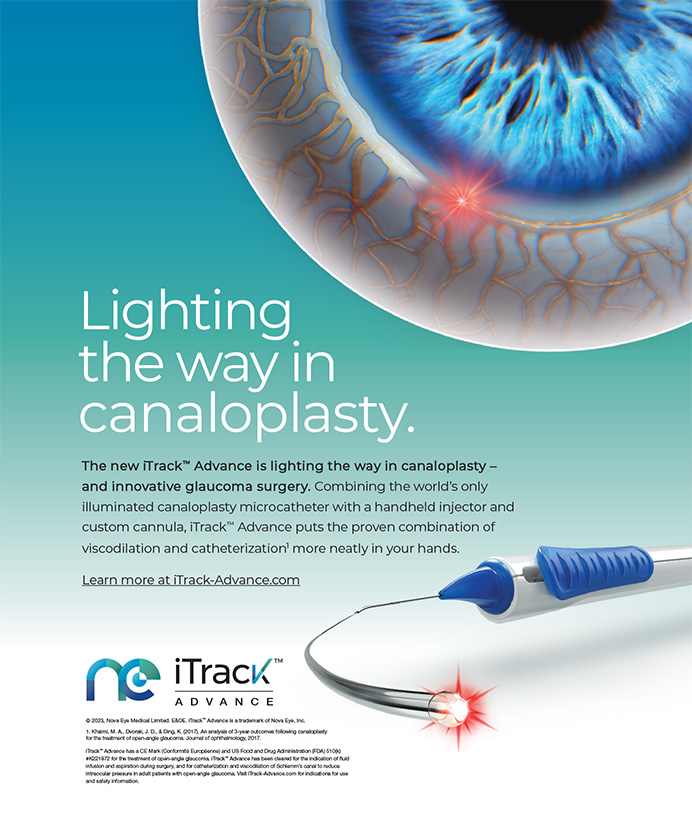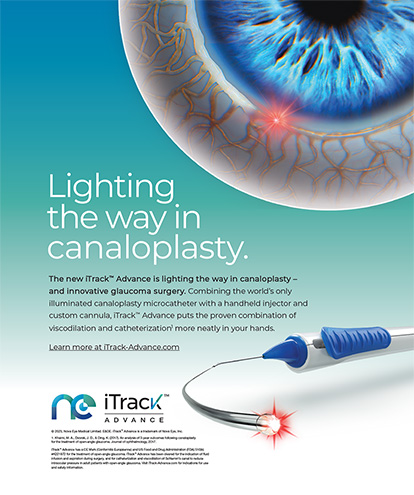Severe ocular surface disease is one of the most challenging ailments in the realm of ophthalmology. Affected patients have profound visual loss, chronic inflammation of the ocular surface and cornea, chronic discomfort, and a poor prognosis for standard keratoplasty. Recent advancements in the various techniques of ocular surface transplantation have led to significant improvements in the overall success rate in the management of these patients.1-10
Procedures for ocular surface transplantation can be divided into autografts and allografts. A conjunctival autograft takes tissue from the same eye or the fellow eye to manage a conjunctival deficiency. Limbal tissue is not used, because this method is not meant to treat limbal disease. In a conjunctival limbal autograft, a normal fellow eye is used as a donor for severe, unilateral limbal deficiency. When limbal disease is present in the fellow eye, it is important that the conjunctival graft include limbal tissue. For bilateral disease, an allograft procedure is required. The two main sources of donor tissue are cadavers and living relatives.
TECHNIQUESKeratolimbal Allograft
The cadaveric donor procedure, also known as keratolimbal allograft, utilizes one or two donor corneoscleral rims in which peripheral cornea, a scleral rim, and a small conjunctival skirt are used to transfer limbal stem cells (Figure 1). The technique is readily available and affords a large quantity of limbal stem cells to be transferred to the recipient eye.
Living-Related Conjunctival Limbal Allograft
Living-related conjunctival limbal allograft is a surgical method in which normal limbal tissue and the conjunctival carrier are harvested from a patient's living relative and transplanted onto the diseased eye. Two trapezoidal limbal grafts, including approximately 6mm of the limbus and extending 5 to 8mm posterior to the limbus, are transplanted (Figure 2). This technique supplies conjunctival tissue as well as limbal cells. However, a smaller number of stem cells are transplanted when compared to the keratolimbal allograft procedure. Additionally, the living-related conjunctival limbal allograft depends on the availability of a relative who agrees to donate.
Ex-Vivo Expansion
Newer methods of stem cell transplantation utilize the technique of ex-vivo expanded limbal cells. Limbal tissue from a donor is expanded in culture before transplantation. Cells can come from a normal fellow eye, a living relative, or a cadaver. This technology is still being developed and is not utilized as commonly as the aforementioned allograft procedures.
Amniotic Membrane Transplantation
Amniotic membrane transplantation is also used in ocular surface reconstruction. The membrane is harvested from a human placenta and can be stored frozen for extended periods of time. These transplants can provide basement membrane that can then be utilized as a substrate for epithelial cell growth. Additionally, amniotic membrane can replace conjunctival tissue in which there are no conjunctival sources available. However, amniotic membrane transplantation alone does not provide stem cells and should not be used as a solitary procedure in patients with significant limbal stem cell deficiency.
POSTOPERATIVE MANAGEMENT
Compared to conventional penetrating keratoplasty, limbal allografts are associated with a significantly higher risk for rejection because the grafted tissue does not have the same immune privilege status as a central corneal graft. The vasculature of the limbal area allows the donor tissue greater access to the immune system. Also, most eyes with ocular surface disease have preoperative inflammation due to the disease state.
Our current immunosuppression protocol includes topical corticosteroids as well as topical cyclosporine. All patients receive systemic immunosuppression with three agents: (1) corticosteroids used 1mg/kg/day and tapered during a 6-month period; (2) tacrolimus, 1 to 4mg b.i.d.; and (3) mycophenolate, 500 to 1,000mg b.i.d. A multidrug regimen is necessary with limbal allograft transplantation to achieve adequate immunosuppression. Additionally, it allows the use of lower doses of individual medications, thereby reducing the risk for side effects. The level of immunosuppression can be justified for this group of patients, because they are highly dependent on the survival of their grafts for functional vision. The necessary duration of immunosuppression depends on a patient's preoperative diagnosis, postoperative course, and whether the rejection of a transplant has occurred. The drug regimen is continued for at least 12 to 18 months for the vast majority of patients, with the corticosteroids reduced to less than 1mg/kg/day for the first 3 months postoperatively.
A number of patients, particularly those with noninflammatory disease such as aniridia, can successfully taper off all systemic immunosuppression at 12 to 18 months. However, patients with underlying inflammatory conditions such as Stevens-Johnson syndrome will often have signs of chronic inflammation and are at risk of rejection upon the discontinuation of systemic immunosuppression. If inflammation persists, or an impeded rejection reaction occurs, it may be necessary to maintain the patients on long-term immunosuppression.
RECOMMENDED TREATMENT ALGORITHM
Based on our experience with severe ocular surface disease, we have established a sequential paradigm for the management of patients with ocular surface disease (Table 1).
Glaucoma Management
On the patient's initial presentation to our clinic, we evaluate IOP. We recommend the aggressive management of elevated IOP by the early placement of a tube shunt in patients who are on more than one topical glaucoma medication. After stem cell transplantation, many patients experience an increase in their IOP. Moreover, their long-term use of multiple topical medications not only becomes less effective but can be toxic to the transplanted epithelial surface. Therefore, it is important that a patient's IOP be stable before ocular surface transplantation.
Eyelid Function
We evaluate the status of the eyelid and lashes before performing ocular surface transplantation. Patients with significant exposure, lagophthalmos, entropion, ectropion, trichiasis, or distichiasis are referred to the oculoplastic service. Significant eyelid abnormalities can cause a breakdown of the epithelium and secondary microbial infection in patients with ocular surface disease. Oculoplastic procedures should improve the function of the eyelids as much as possible prior to ocular surface transplantation.
Ocular Surface Inflammation Management
Limbal allografts transplanted to an inflamed ocular surface have a significantly poorer prognosis than those in which the inflammation has been reduced. If significant conjunctival inflammation is present, topical and systemic immunosuppression should begin weeks to months before transplantation to improve the overall success rate of the procedure.
Ocular Surface Transplantation
Once the IOP stabilizes, lid anatomy and function are restored, and the ocular inflammation is reasonably controlled, ocular surface transplantation may be performed (Figure 3). The selection of technique is based on several factors. If the patient has unilateral disease, a conjunctival limbal autograft is the procedure of choice because it does not run the risk of failure secondary to immune rejection. For patients with bilateral disease, the most common choices of donor tissue are the cadaveric procedure (keratolimbal allograft) or the living-related conjunctival limbal allograft. For the vast majority of patients with limbal deficiency without extensive conjunctival disease, we advocate the use of keratolimbal allograft because of the availability of cadaveric donor tissue and the increased quantity of stem cells available for transplantation.
If patients have extensive conjunctival disease, we believe the living-related conjunctival limbal allograft provides much needed healthy conjunctival cells in addition to limbal tissue. Most recently, we have combined keratolimbal allograft with living-related conjunctival allograft in patients who have the most severe ocular surface disease. This combination maximizes the advantages inherent to each procedure.
Keratoplasty
In patients whose IOPs are controlled, whose ocular lid function is reasonably healthy, and who have a stable ocular surface, we will consider keratoplasty as a means of visual rehabilitation. The vast majority of patients with a failed ocular surface have subsequent stromal scarring and loss of vision even if the ocular surface has been restored. These individuals then undergo a penetrating or a lamellar keratoplasty for visual rehabilitation. If there is significant stromal scarring but good endothelial function, a lamellar keratoplasty will reduce problems with endothelial rejection. If the endothelium is involved in the disease process, a penetrating keratoplasty is required.
SUMMARY
Ocular surface transplantation has changed greatly during the last decade. Patients with severe ocular surface disease now have a chance of obtaining reasonable visual function. Surgeons need not only address the corneal and ocular surface problems, but they must also aggressively treat glaucoma and oculoplastic problems prior to ocular surface transplantation. It is extremely important to control inflammation both pre- and postoperatively with systemic and topical immunosuppression to maximize outcomes.
Improvements in the success rates of transplantation procedures are still needed, because patients with the most severe ocular surface damage and total conjunctival failure are not candidates for ocular surface transplantation. The development of conjunctival substitutes, as well as techniques to reverse severe keratitis sicca, will allow patients with total ocular surface failure the opportunity for visual recovery.
Edward J. Holland, MD, is Director of Cornea at the Cincinnati Eye Institute and Professor of Ophthalmology at the University of Cincinnati in Ohio. He states that he holds no financial interest in any company or product mentioned herein. Dr. Holland may be reached at (859) 331-9000, extension 3064; eholland@fuse.net.
Gary S. Schwartz, MD, is in private practice at Associated Eye Care in St. Paul, Minnesota. He states that he holds no financial interest in any company or product mentioned herein. Dr. Schwartz may be reached at (651) 702-0436; gsschwartz@associatedeyecare.com.
1. Kenyon KR, Tseng SCG. Limbal autograft transplantation for ocular surface disorders. Ophthalmology. 1989;96:709-723.2. Tsai RJF, Tseng SCG. Human allograft limbal transplantation for corneal surface reconstruction. Cornea. 1994;13:389-400.
3. Tsubota K, Toda I, Saito H, et al. Reconstruction of the corneal epithelium by limbal allograft transplantation for severe ocular surface disorders. Ophthalmology. 1995;102:1486-1495.
4. Kwitko S, Raminho D, Barcaro S, et al. Allograft conjunctival transplantation for bilateral ocular surface disorders. Ophthalmology. 1995;102:1020-1025.
5. Holland EJ. Epithelial transplantation for the management of severe ocular surface disease. Trans Am Ophthalmol Soc. 1996;19:677-743.
6. Holland EJ, Schwartz GS. The evolution of epithelial transplantation for severe ocular surface disease and a proposed classification system. Cornea. 1996;15:549-556.
7. Croasdale CR, Schwartz GS, Malling JV, et al. Keratolimbal allograft: recommendations for tissue procurement and preparation by eye banks, and standard surgical technique. Cornea. 1999;18:52-58.
8. Holland EJ, Schwartz GS. The evolution and classification of ocular surface transplantation. In: Holland EJ, Mannis MJ, eds. Ocular Surface Disease. New York: Springer; 2002:149-157.
9. Daya SM, Holland EJ, Mannis MJ. Living-related conjunctival limbal allograft. In: Holland EJ, Mannis MJ, eds. Ocular Surface Disease. New York: Springer; 2002: 201-207.
10. Schwartz GS, Tsubota K, Tseng SCG, et al. Keratolimbal allograft. In: Holland EJ, Mannis MJ, eds. Ocular Surface Disease. New York: Springer; 2002: 208-222.
11. Holland EJ, Schwartz GS. The Paton Lecture—ocular surface transplantation: 10 years' experience. Cornea. 2004;23:425-431.


